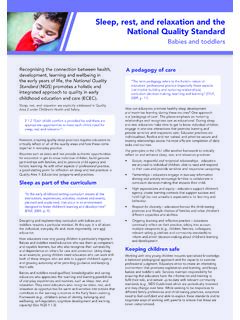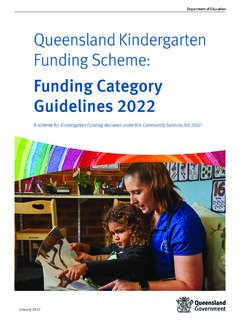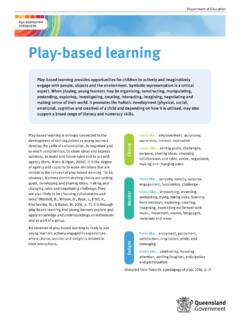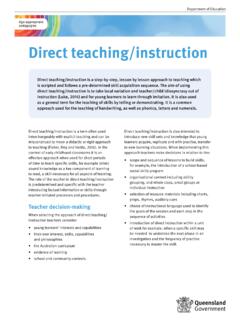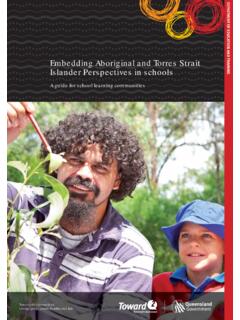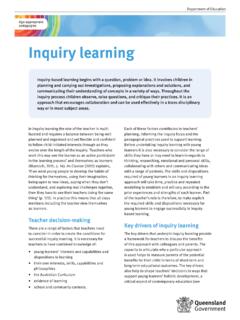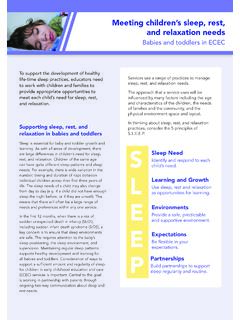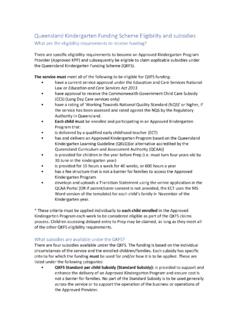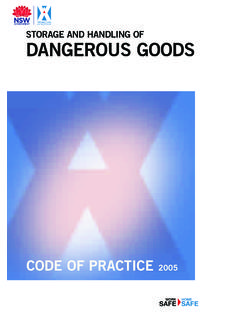Transcription of Information sheet 6 - Work Health and Safety Act 2011
1 Page 1 of 4 Information sheet 6 work Health and Safety Act 2011 (Qld)Approved providers, service supervisors and management, and educators of early childhood education and care (ECEC) services have a responsibility to ensure that they meet their legal obligations. This includes meeting the requirements of the work Health and Safety Act 2011 (Qld).What is the work Health and Safety Act 2011 (Qld)?The work Health and Safety Act 2011 (Qld) sets out the principles for building healthy and safe workplaces. The Act identifies how duty of care and responsibilities for work Health and Safety (WHS) must be WHS Act protects the Health and Safety of employees, contractors, subcontractors, outworkers, apprentices and trainees, work experience students, volunteers and employers who perform work . The WHS Act was introduced by the Queensland Government, along with other states and territories, to harmonise work Health and Safety legislation (formerly referred to as occupational Health and Safety legislation) across is work Health and Safety ?
2 work Health and Safety (WHS) seeks to ensure that employers uphold their duty of care to their employees, and that employees make safe choices in the duty of careHaving a duty of care means that people and organisations delivering goods and services must avoid acts or omissions that could reasonably and foreseeably cause harm to others. Approved providers, service supervisors and management, and educators have a duty of care to protect the Safety and wellbeing of all children, families and staff using their ECEC service. The principle of duty of care is embedded in many laws and regulations which aim to protect and maintain the Health , wellbeing and Safety of others. For ECEC services, duty of care obligations exist under the: work Health and Safety Act 2011 (Qld) Child Protection Act 1999 (Qld) Education and Care Services national Law (Qld).Duty of care principles also inform codes of ethics and professional behaviour, such as the Early Childhood Australia (ECA) Code of Ethics (ECA, 2006).
3 WHS and inclusion of all childrenWHS and duty of care are factors in deciding how to create ECEC programs and environments that include all children, including children with disability and complex additional needs. Every program needs to be accessible and safe for all children, educators and other staff. Before making adjustments to their program or environment, ECEC services will carefully consider the benefits and risks of all the options. Many risks can be managed with training and support. For example, if a child requires help in moving in and out of a wheelchair, educators will learn how to do this in a way that is safe for the child and the adults involved. This type of risk management is not limited to children with disability. An ECEC service will Photo: tanyepm (CC0)Page 2 of 4have policies and procedures that control risks in many areas, such as lifting children, nappy changing and use of hazardous is responsible for WHS?Everyone in a workplace has a role to play in delivering a safe and healthy work environment.
4 However, the WHS Act places primary duty of care responsibilities for Health and Safety on the People Conducting a Business or Undertaking (PCBUs). A PCBU is a business or other undertaking, conducted for profit or not for profit. In ECEC services, the PCBU is generally the approved provider: that is, the owner of the service or its governing body. As the holder of the primary duty of care responsibilities under the WHS Act, the PCBU must ensure, so far as is reasonably practicable, the Health and Safety of their workers as well other people, such as children, in the workplace. This duty of care cannot be transferred to another person. However, officers of a PCBU, such as the Nominated Supervisor and management, as well as educators and other people at a workplace, have responsibilities under the WHS Act to participate in eliminating and minimising risks to Health and WHS Act also requires the PCBU to consult with workers and with elected Health and Safety Representatives (HSR) about matters that directly affect in ECEC servicesEducators in ECEC services are particularly susceptible to certain types of workplace injury and illness.
5 These are: musculoskeletal injuries (body stresses and fractures): often caused by lifting and carrying objects or by slips, trips and falls vaccine-preventable illnesses (Workplace Health and Safety Queensland, 2007).Workcover Queensland can provide help in improving work Health and Safety in ECEC services. Through the Injury Prevention and Management program (IPaM), ECEC services can access tools, Information and support services to improve Health and Safety , injury management and workplace culture. (See the case study of Sesame Lane Childcare service s involvement in the IPaM program.)Ensuring a safe workplace is also relevant to the overall quality of a service. For example, as part of an assessment and rating under the national Quality Standard for early childhood education and care, services are assessed to determine whether every reasonable precaution is taken to protect children from harm and any hazard likely to cause injury (Element ) and premises, furniture and equipment are safe, clean and well maintained (Element ).
6 Managing WHS risks in your serviceImproving Health and Safety in your ECEC service begins with risk management. There are four steps in managing WHS risks:1. Identifying hazards: what could cause harm?2. Assessing risks: how serious is the harm, and how likely that it could happen?3. Controlling risks: implementing effective control measures4. Reviewing control measures: how well are they working? (Safe work Australia, 2012).These steps can be conducted as part of existing planning and review processes, such as reviewing your Quality Improvement Plan (QIP) or policy and procedures documents. For advice on developing a risk management framework for your service, see Information sheet 11 Developing decision-making and risk management frameworks in this : LimePage 3 of 4 Areas covered by the WHS ActThe WHS Act outlines the range of issues that the PCBU (approved provider) must deal with, as far as is reasonably practical. These areas are wide-ranging and include: providing and maintaining a safe working environment providing and maintaining safe plant, structure andsystems of work ensuring the safe use, handling, storage andtransport of plant, structure and substances ( toxicchemicals, dusts and fibres) providing adequate facilities for the welfare of workers( washrooms, lockers and dining areas) providing workers with Information , instruction, trainingor supervision required for them to work safely andwithout risks to their Health monitoring the Health of their workers and theconditions of the workplace maintaining any accommodation owned or undertheir management and control to ensure the healthand Safety of workers occupying the premises(Workplace Health and Safety Queensland, 2015).
7 Tools for complianceIn addition to the WHS Act, there is a work Health and Safety Regulation 2011, which provides detailed Information on how to prevent or minimise risks related to particular types of work , environments and equipment. Provisions in the WHS Regulation 2011 (like the WHS Act) are legally enforceable. Approved providers can also refer to codes of practice for advice on how to meet legislative and regulatory requirements for work Health and Safety . Codes of practice are available for a range of work Health and Safety areas, such as: first aid how to manage work Health and Safety risks work Health and Safety consultation, cooperationand codes of practice are not legally enforceable, they provide a benchmark for how to meet WHS requirements. If a workplace risk is not covered by the WHS Regulation 2011 or a code of practice, then a PCBU must choose an appropriate strategy to manage exposure to an identified risk, so far as is reasonably to issuesEach workplace is required to have a procedure in place for dealing with WHS issues and complaints.
8 The WHS Regulation 2011 sets out the minimum requirements for such procedures, which include: notification at any time, by any party immediate communication to resolve the issue a range of factors to be considered in theresolution process agreement on the resolution in WHS incidentsThe WHS Act requires PCBUs to notify relevant agencies of particular Health and Safety incidents. The Act states that an incident is notifiable if it results in the death, serious injury or serious illness of a person or involves a dangerous incident . Each workplace will have processes and training in place to ensure that staff understand and meet these requirements. For example, the Queensland Department of Education website explains the process for notifying Health and Safety Cover QueenslandWork Cover Queensland oversees the Queensland work Health and Safety Act 2011 and provides a comprehensive range of resources to enable PCBUs, officers and workers to meet their obligations under the Act.
9 In addition, there are two national bodies that provide Information on work Health and Safety : Safe work Australia, the national body in chargeof developing work Health and Safety and workers compensation policy Comcare, which assists at a national levelin the education, assurance and enforcementof WHS : Welcome to the FoldPage 4 of 4 Where to find more informationYou can access a range of resources on how to comply with the work Health and Safety Act 2011 from the work Cover Queensland website. This includes a useful introductory guide to the Act. Safe work Australia also produces a range of fact sheets on WHS risks, plans and to unpack relevant legislationApproved providers, service supervisors and management, and educators of early childhood education and care (ECEC) services are required to comply with a range of state and federal laws and regulations. To help you unpack the relevant legislation, try asking these key questions: What are the goals of the legislation whatis it trying to achieve for individuals and thewider community?
10 What are the responsibilities of the ECEC service s management team? What are the responsibilities of individualmembers of the governing body? What responsibilities can be delegated to theECEC service s officers, such as the NominatedSupervisor and the management team? What measures, such as plans, policiesand procedures, need to be in place to enablethe ECEC service as a whole to meet its legalobligations under the relevant Act or regulation?It is also important to keep abreast of changes to legislation that may occur from time to time. You can download a copy of the current legislation from Queensland Legislation government department or statutory authority that is responsible for oversight of the legislation also provides resources, such as plain English guides and fact sheets, to help you better understand the requirements of the legislation. These include:Fact sheets and guides ( work Cover Queensland).Photo: LimeReferencesEarly Childhood Australia (ECA). (2006). Code of ethics.
